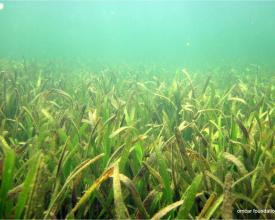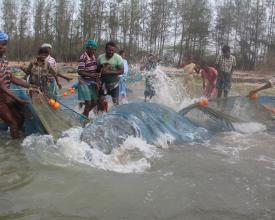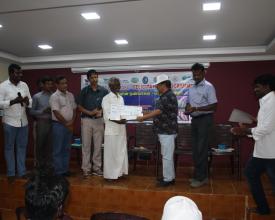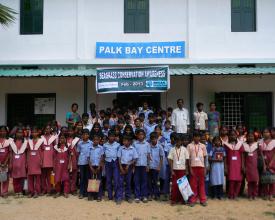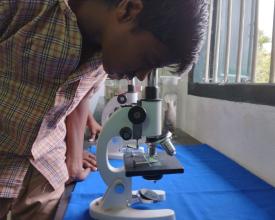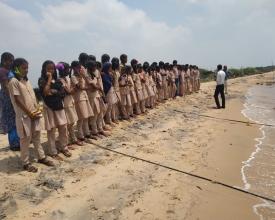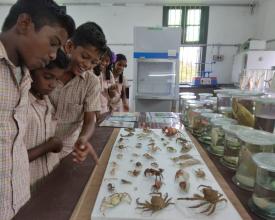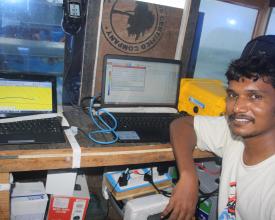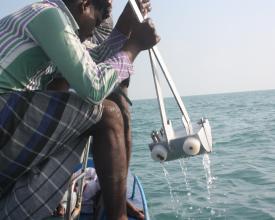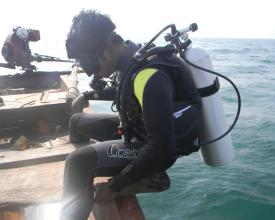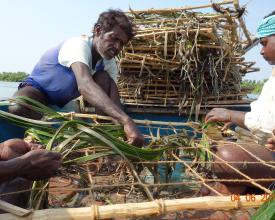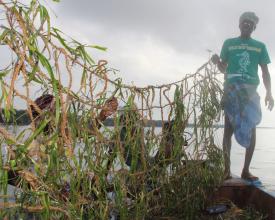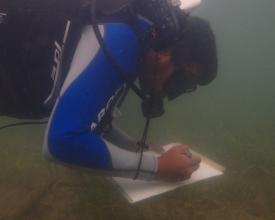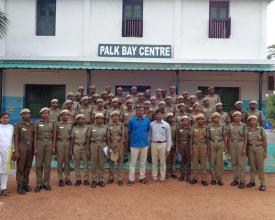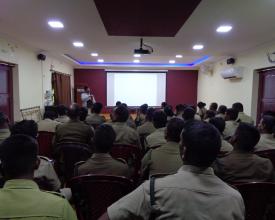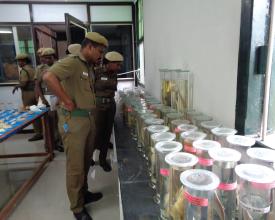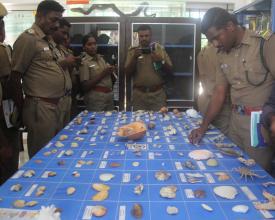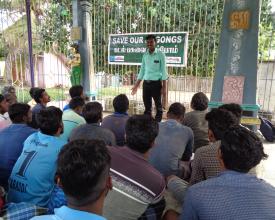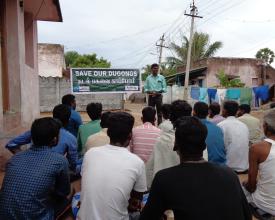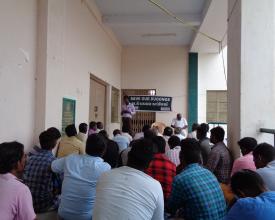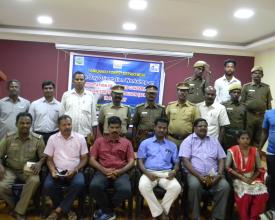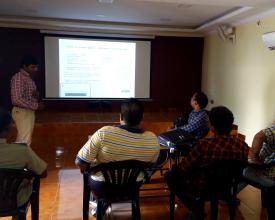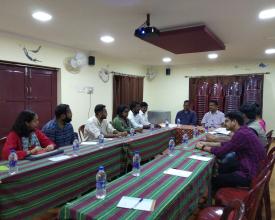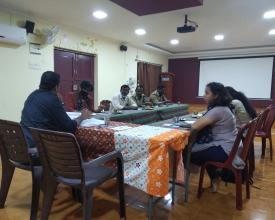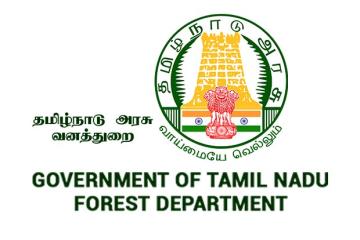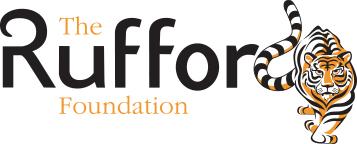
Dugong - Seagrass Conservation in Palk Bay, India
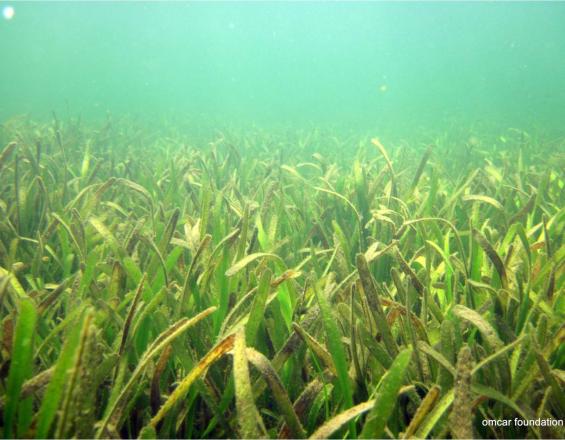
OMCAR Foundation started for the conservation of dugongs and coastal habitats in Palk Bay. Our organization mapped the seagrass beds using acoustic technology, documented the stranding of animals for more than a decade to create awareness among fishers, and developed the policy in Government through our scientific publications and technical support. Dugong rescue and release groups (friends of dugongs) were formed at the grassroots by Tamil Nadu Forest Department with Wild Life Institute of India and OMCAR, which helped to rescue and release the dugongs from fishing nets. Additionally, omcar developed low-cost, eco-friendly seagrass restoration methods using bamboo and coconut coir ropes, which are being adapted for large-scale replication in the future. As a result of continuous effort, India's first dugong conservation reserve government order has been released in early 2022.
Context
Challenges addressed
1. Lack of baseline information about the dugong population and their feeding habitats (seagrass beds). So, we worked more than a decade to conduct research and documentation.
2. Lack of awareness among stakeholders about the conservation dugongs across all levels. So, we regularly documented the local dugong deaths, strandings and seagrass associated animals and created awareness in villages, schools and by writing popular articles in news papers, websites and social media.
3. There was no conservation groups in grassroot level in Palk Bay. So, Tamil Nadu Forest Department, Wild Life Institute of India and OMCAR formed such groups in the last five years resulting successful rescue and relase of dugongs.
Location
Process
Summary of the process
Creating awareness among the fisherfolks (building block 1) helped our organization to develop a good rapport with fishers. So, they participated in our seagrass mapping (building block 2) and also developed an eco-friendly and low-cost seagrass restoration method (building block 3) and dugong conservation. It took nearly ten years to build the first three blocks. Then, OMCAR conducted technical training for the government staff (building block 4) about seagrass restoration and dugong rescue and release and also organizes the local fishers for rescue and release of dugongs through networking (building block 5). As a next step, our organization has been working with the Tamil Nadu Forest Department for the declaration of dugong conservation in reserve in Palk Bay which is in progress.
Building Blocks
Creating Awareness about Marine Conservation in Palk Bay (2007 - 2022)
In 2007, a 600 km solo sea kayak was carried out along the coast of Tamil Nadu (southeast coast of India) for creating awareness about the conservation of local marine ecosystems including dugongs, seagrasses, coral reefs, and mangroves. In the following years, about 40000 people including school students, university students, fisherfolks, and government officials have attended our marine conservation awareness events in the last 15 years through folk music, school level awareness education programs, competitions, seminars, training, field trips, and distribution of awareness materials. This continuous awareness at the local and sub-national level has built rapport with the stakeholders for the rescue and release of dugongs, and mapping and restoration of seagrass beds.
Enabling factors
- Capacity building of staff and volunteers from the local community.
- We produced a large set of underwater photos and videos of seagrass habitats and dugongs from the local coast.
- We set up our marine education center called “Palk Bay Environmental Education Centre” in 2011.
- We distributed more than 25000 awareness materials to the stakeholders in the last 15 years.
- We organized (seminars/training/camps/field trips) on nonprofit basis for school students, university students, fisherfolks as well as government officials.
Lesson learned
- Continuous efforts for a few years in nature conservation awareness can change the mindset and support from local stakeholders.
- Producing our photos, and videos and sharing our field experience in dugong rescue, release, and seagrass restoration are important tools.
- The capacity building of staff and volunteers from the local community helped to spread awareness for more than a decade continuously.
- Setting up our marine education campus close to the target area (seagrass beach) is a major advantage, which gives direct exposure to the visitors.
Resources
Participatory Survey for Mapping Seagrass Beds in northern Palk Bay (2010 - 2017)
Before this survey, there was no accurate scientific data available about the extension of seagrass beds in northern Palk Bay. The preparation started in 2010, and the actual survey started in 2013 and was published in 2018. We had to come across issues related to funding, logistics, and how to build technical knowledge within our organization. Due to poor water quality, it was difficult to map the seagrass beds using satellite imagery. So, OMCAR built a survey boat (a modified fishing boat), developed skills in GIS and acoustic methods, and scuba equipment from 2010 to 2013. With the funding from NRDMS, DST, Government of India – OMCAR started to conduct the acoustic survey in shallow nearshore waters in northern Palk Bay for proposing the site as a conservation reserve. This was the first such attempt to survey the seagrass beds using acoustic technology in India. The final reports were submitted to Government and also published in 2018. This baseline survey revealed the distribution of seagrass beds in the ‘dugong conservation reserve’ up to 35,000 hectares of northern Palk Bay, so 500 square kilometers area in and around this seagrass bed has been selected to be declared as a” Dugong Conservation Reserve” based on this research by Government.
Enabling factors
Our team consists of a marine biologist (founder of OMCAR), staff, and volunteers from the local community. This enabled us to plan for the seagrass survey methods using both scientific and traditional knowledge.
Low-cost navigational devices were assembled for this survey to navigate the boat perpendicular to the coast along the transects.
Local fishers who attended our capacity building training have helped with their traditional knowledge for planning suitable months and time to carry out the seagrass survey.
Lesson learned
- Seagrass acoustic survey can provide accurate, local-based information about the distribution of seagrass meadows for conservation planning.
- Local people's participation and support are important, which will help for the safety of the survey crew, and the selection of suitable months and time for the survey.
- As the results are important as evidence to prove the total area of seagrass beds for declaring the protected site, technical knowledge, and dedicated staff are essential.
- Training and capacity building of local volunteers from the fishing community is important for participatory seagrass surveys.
Developing Participatory, Eco-friendly and Low-cost Seagrass restoration method (2016 - 2022)
Restoration of seagrass beds is different from the restoration of terrestrial plants, as it needs to work underwater ecosystem. Seagrasses reproduce through sexual reproduction and vegetative reproduction. In seagrass restoration, the seagrass sprigs were removed from the donor site and transplanted to degraded sites. There were already established methods obtained from scientific publications using 1m2 PVC frames for transplanting seagrasses. Although this method is successful, we determined not to use the PVC plastics that need to be permanently fixed on the seafloor for seagrass restoration. So, OMCAR discussed with local fishers to develop an eco-friendly, low-cost method for seagrass restoration. For the first time in India, we used bamboo frames and coconut rope frames as an eco-friendly frames for fixing the transplanted seagrass sprigs from healthy sites to degraded sites. Local fishers were trained and involved in the seagrass restoration work. As both bamboo and coir ropes are available locally, they are cost-effective, and they can be presently fixed on the seafloor until they get degraded naturally. This method is now being adapted and replicated by the government for seagrass restoration in other areas of Palk Bay and the Gulf of Mannar.
Enabling factors
- The participatory seagrass restoration procedure is the key strength of this method, which is developed by OMCAR with the consultation of fisherfolks.
- Bamboo and coconut coir ropes are degradable, so they will not pollute the sea like PVC frames.
- Bamboo and Coconut coir ropes are locally available, so they are low-cost to be used in large-scale participatory seagrass restoration.
- The results of this project have been published in a scientific journal.
Lesson learned
- Eco-friendly restoration method ensures the sustainability and recognition of the government.
- Participation of the local community in seagrass restoration methods increases their sense of responsibility.
- Locally available raw materials reduce the cost of the restoration accessories while reducing the use of plastics.
Technical Training for Seagrass Restoration and Dugong Rescue and Release for Forest Department (Since 2017)
After a decade of technical and in-situ conservation experience in dugongs and seagrasses, OMCAR received recognition from Tamil Nadu Government to organize technical orientation sessions for the newly recruited trainees of Range Officers, Foresters, and Guards at our center. Since 2017, our organization received about 2500 trainees of Tamil Nadu Forest Academy cadres for organizing training sessions. Our team shares explain of the seagrass acoustic mapping methodology, seagrass restoration methods using eco-friendly cost-effective materials, how to rescue and release the dugongs, and how the networking and capacity building of fisher volunteers is effective in the conservation of dugongs, and restoration of seagrass beds. OMCAR has been providing this service on a nonprofit basis.
Enabling factors
- Technical knowledge of eco-friendly and low-cost seagrass restoration methods in our team.
- Technical knowledge on seagrass mapping using acoustic technology in our team.
- Experience in networking and enabling the volunteer network for responding to dugong strandings, rescue, and release.
Lesson learned
- Long-term efforts in developing grassroots conservation techniques can be recognized and benefit the Government.
- Technical expertise and experience are invaluable assets for grassroots conservation organizations.
Networking and Capacity Building of Volunteers for Dugong Rescue and Release (Since 2016)
OMCAR signed MoU with government institutions (Wild Life Institute of India and Sacon) to work with other stakeholders efficiently and quickly respond to the dugong rescue and release in Palk Bay. With the partnership of Tamil Nadu Forest Department and Wild Life Institute of India, OMCAR established “Friends of Dugongs” in every fisher village in northern Palk Bay. The volunteers were trained to respond to a dugong strandings, and how to organise rescue and release with forest department. The volunteers have been actively supporting to share the information about dugong sightings, rescued and released dugongs in the past six years. As a result, several dugongs have been rescued and released in Palk Bay, and fishers received rewards and honoured by government. OMCAR published its stranded marine mammals record in a scientific journal, which helped as evidence for the need for the establishment of conservation reserve.
Enabling factors
- The signing of the Memorandum of Understanding with Government institutions helped to build a strong partnership.
- The capacity building of volunteers from the fishing community enabled the successful rescue and release of dugongs from fishing nets.
- Recognition and rewards received by fishermen, who rescued and released the dugongs created a positive encouragement.
- Publication of dugong strandings supported the establishment of a dugong conservation reserve in Palk Bay.
Lesson learned
- Grassroot conservation needs cooperation and mutual support from the government, NGOs, the public, and research institutions.
- Immediate response for the stranded dugongs, rescue, and release work with the participation of volunteers from coastal villages was possible through social media networking.
- Encouraging the community volunteers helped to enhance the dugong conservation further.
- Scientific publications and documentation are important for NGOs working in grassroots conservation.
Providing Technical support for Planning Dugong Conservation Reserve in Palk Bay (2017 - 2022)
With the partnership of Wild Life Institute of India, OMCAR has been providing technical support to the Forest department in Pudukkottai and Thanjavur district for creating the boundary of dugong conservation reserve based on our published acoustic survey results from NRDMS, Department of Science and Technology project. OMCAR experts had been working with frontline staff, district forest office, and Conservator office for developing the plan, GIS mapping of the dugong conservation reserve, and by sharing the data of its 12 years of marine mammal stranding observations in northern Palk Bay.
Enabling factors
- Technical expertise within the organization and willing to volunteer at the government offices at any time.
- Published papers in scientific journals, data, photographs of dugong strandings, and seagrass acoustic survey.
- Partnership with Wild Life Institute of India through MoU helped to work together for the common goal of supporting the forest department in establishing the dugong conservation reserve in Palk Bay.
Lesson learned
- Persistence and patience are important when working with multiple stakeholders for long-term conservation goals.
- Each stakeholder has their own official working methods, and limitations, but at the same time, they have a specific capacity to contribute to the conservation of dugongs and seagrass beds.
- As a grassroots NGO, servant leadership will work when working with multiple stakeholders for the conservation goal.
Impacts
1. Increased awareness among local stakeholders helped to rescue and release six dugongs (total population is estimated ~150 in Palk Bay) with the joint effort of local fishers with WII, Forest Department, and OMCAR Foundation.
2. Low cost and eco-friendly seagrass restoration methods are helpful to involve the local community and natural materials available from the local coast for seagrass transplantation in degraded sites. The material cost of the bamboo frame was 46% lesser than the PVC frame, and the same cost of the coir frame was 102% lesser than the PVC frame. The labor cost of the bamboo frame was 47% lesser than the PVC frame, and the same cost of the coir frame was 33% lesser than the PVC frame. Thus, naturally degradable bamboo and coir nets are better, whereas the coconut coir net method is the best as it is relatively low cost, easily available, and suitable for large-scale, community-based seagrass restoration. The situation of seagrass degradation has to be further improved after the implementation of the dugong conservation reserve in the later months of 2022.
3. Our scientific publications on seagrass mapping, seagrass restoration, and dugong stranding records support the government for the establishment of a dugong conservation reserve in Palk Bay.
Beneficiaries
6 dugongs have been rescued (2016-2021)
32000 school students
1159 trainees of Tamil Nadu Forest Academy
13600 fishermen
3750 University students
Sustainable Development Goals
Story
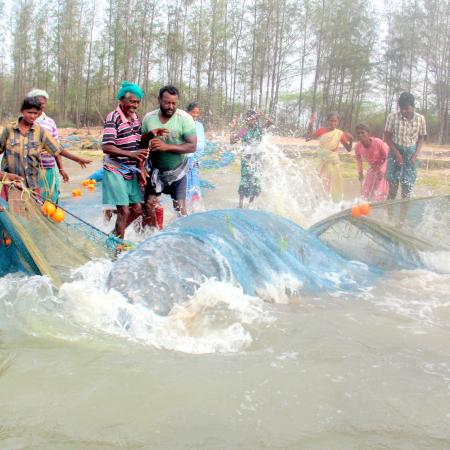
A group of fishers in northern Palk Bay went fishing like any other regular day. They are all poor fishers using shore seines in nearshore waters. They get up at the midnight and start fishing at 3 to 4 am, which includes both men and women. Suddenly they spotted a huge dugong caught in their fishing nets, which is traditionally considered a delicious food. However, these fishers attended awareness events organized by OMCAR and they are part of the "Friends of Dugongs Volunteer Group" formed by the Tamil Nadu Forest Department, WII, and OMCAR partnership.
So, they immediately called the Forest department, OMCAR, and WII team to inform them about the dugong caught in their fishing net. The teams arrived at the spot and safely released the dugong back to the sea. This incident is a sample of how the dugongs have been safely rescued and released into the sea by local fisher groups after the continuous efforts for creating awareness among the fisherfolks for dugong rescue, release, and seagrass conservation.

